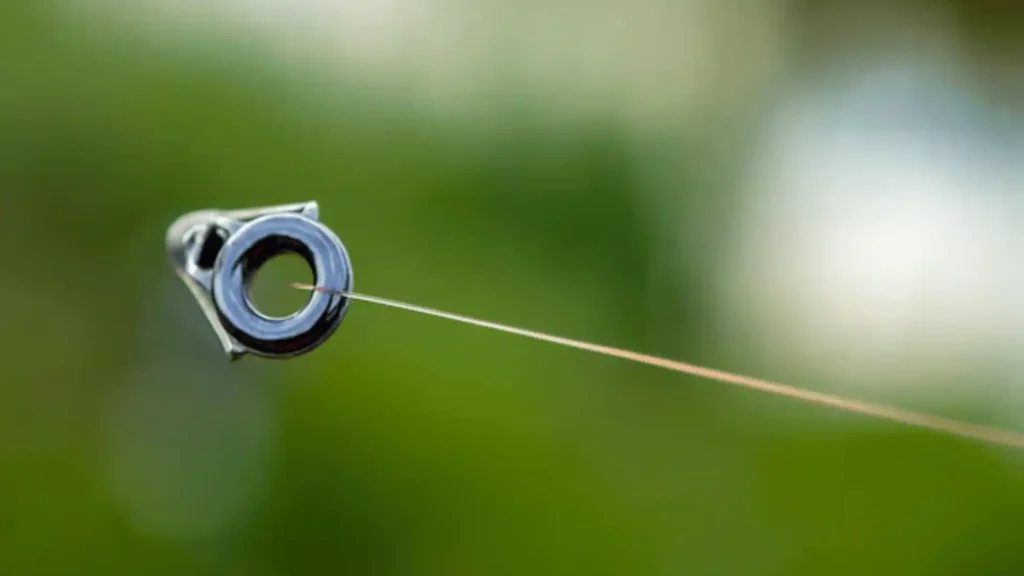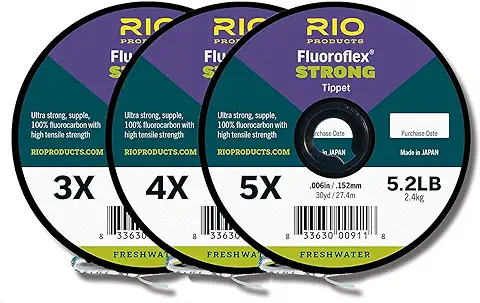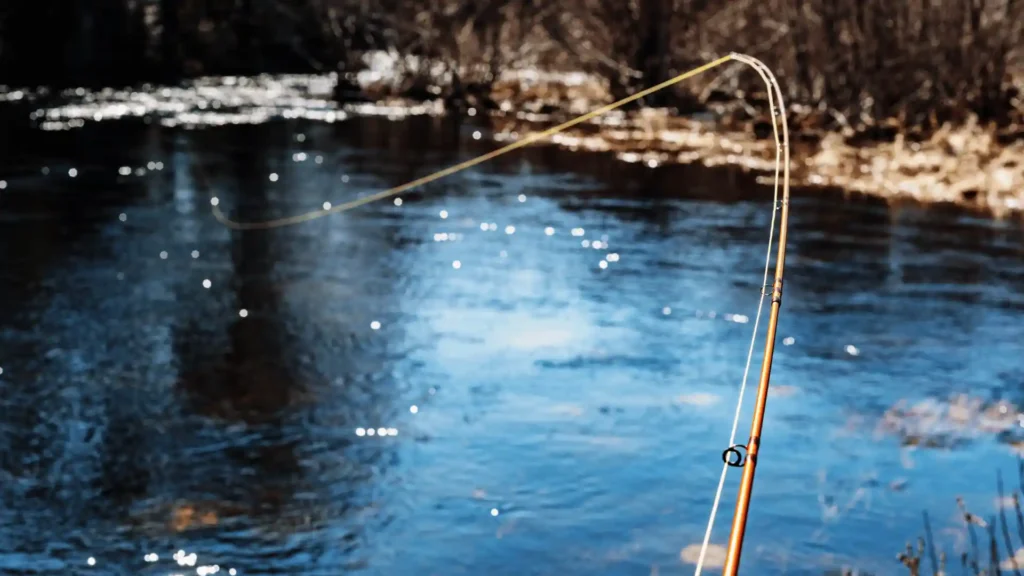An In-Depth Guide to Fly Fishing Tippet | All You Need To Know

Have you ever been in a fly shop, staring at a bunch of tippet spools, not sure which ones you need? Or maybe you’ve been out fishing, changing flies and struggling to fit a big piece of tippet through a tiny hook eye?
Fly fishing is a fascinating sport that requires attention to detail and a deep understanding of the equipment involved.
But, many fly fishers don’t pay much attention to tippet, even though. it’s just as important as having the right rod, line, and leader. It’s the last thing that connects everything to your fly.
All the practice, money spent on gear, and hopes for a good catch come down to that one little piece of plastic tied to your fly. So yeah, it’s pretty important.
In this guide, I will guide you from my 16 year of experience i fishing and tell you all about fly fishing tippet, it’s uses, types, and size.
*Note: This article will cover freshwater tippet applications, suitable for fly fishing for bass, trout, panfish, carp, or catfish. If you're targeting toothy fish like musky, walleye, or gar, you'll need to look into wire bite tippet as well.
Must Read: How to Choose the Right Tippet for Successful Fly Fishing
Also: Understanding Fly Fishing Leaders and Tippets? Expert Guide (2024)
What Exactly is a Tippet?
Tippet is a thin, translucent material strand connecting the leader to the fly in fly fishing. It is typically made of nylon or fluorocarbon, although copolymer options are also available.
The Tippet is an invisible extension of the leader, allowing for a more realistic presentation of the fly to the fish.

However, to add to the confusion, you might come across tippet spools labeled as copolymer or multi-polymer. These tippets are likely made of nylon and other polymers, possibly including some secret ingredients.
Are you still following along? I understand the fishing industry sometimes keeps things straightforward.
The Role of Fly Fishing Tippet
The primary purpose of the Tippet is to create a seamless transition from the leader to the fly. It provides a level of invisibility that helps to mimic the natural movement of insects and nymphs, making it more likely for fish to take the bait.
Additionally, the Tippet helps to transfer the energy from the fly line to the fly, ensuring a smooth and accurate cast.
Choosing the Right Tippet Size
Selecting the appropriate tippet size is crucial for a successful fly fishing experience. Tippet sizes are denoted by an ‘X’ rating, which represents the breaking strength and diameter of the material.

The general rule of thumb is to divide the fly size by three to determine the recommended tippet size. For example, a size 14 fly would typically require a 4X tippet.
However, it’s important to note that this is just a guideline, and other factors should be considered. The fish’s size, the water’s conditions, and the type of fly being used can all influence the choice of tippet size.
It’s best to experiment and adjust accordingly to find the perfect balance.
Nylon Vs Fluorocarbon Vs Mopolymer /Multipolymer
Anglers often wonder, which is the best, Nylon vs Fluorocarbon vs Copolymer/Multipolymer? Picking the right tippet material is crucial for fishing success, so let’s break down the differences.
Nylon Tippets: Nylon is popular for being affordable and versatile. It’s strong, flexible, and works in many conditions. Nylon floats naturally, which is good in some situations, but it’s more visible underwater than fluorocarbon.
Fluorocarbon Tippets: Fluorocarbon is almost invisible underwater, great for spooky fish. It sinks fast, stays straight, and resists abrasion. It’s pricier than nylon but worth it for certain fishing scenarios.
Copolymer/Multipolymer Tippets: These combine nylon and fluorocarbon qualities. They’re strong, abrasion-resistant, and less visible underwater than nylon. They’re not as invisible as pure fluorocarbon but offer good performance at a lower price.
When choosing tippet, consider your fishing conditions and target fish. If visibility matters, especially in clear water, go for fluorocarbon or copolymer. For general fishing, nylon is budget-friendly.
Also, think about how often you fish and your budget. Occasional anglers can get by with a few quality spools, while frequent anglers might need more. Balancing strength, diameter, and cost is key.
Be wary of bargain brands claiming high strength. Cheaper options might sacrifice quality. Stick to trusted brands like Orvis, Rio, or Scientific Anglers for reliable tippets.
Comparison Table: Nylon Vs Fluorocarbon Vs Copolymer/Multipolymer Tippets
| Material | Advantages | Disadvantages | Best Suited For |
|---|---|---|---|
| Nylon | Affordability, Versatility , Excellent knot strength, Flexibility | Higher visibility Underwater, Lower density than water | General-purpose fishing , Fishing with larger flies |
| Fluorocarbon | Near-invisibility underwater, Quick sinkingm, Excellent abrasion resistance | Higher cost, Less supple than nylon, Prone to memory effect | Clear water fishing, Fishing with small flies , Abrasion-prone environments |
| Copolymer/Multipolymer | Enhanced knot strength , Abrasion resistance , Balances invisibility with suppleness | Not as invisible as pure fluorocarbon , Moderate cost compared to fluorocarbon | Versatile fishing conditions, Fishing with moderate-sized flies |
What Is the Difference Between the Leader and Tippet?
In fly fishing, there are two essential parts: tippet and leader. They have different jobs but work together to help you catch fish. Let’s learn about them.
What is a Leader?
A leader is a part of your fishing line. It connects the thick line to the thin tippet, where you tie your fly.
The leader is more comprehensive at the top near the main line and gets lighter towards the tippet. This helps you cast accurately.
Critical Things About a Leader:
- Tapered Design: Leaders are made to help you cast smoothly and accurately.
- Visibility: Leaders are often transparent, so fish can’t see them easily underwater.
- Strength: Leaders are strong enough to handle big fish.
- Toughness: Leaders are made to resist getting damaged by rocks, plants, or fish teeth.
- Knot Strength: Leaders need strong knots to stay connected to the main line and tippet without breaking.
What is Tippet?
Tippet is the thinnest part of your line, where you tie your fly. It connects to the leader and helps your fly move naturally in the water.
Critical Things About Tippet:
- Thin: Tippet is much lighter than the leader, making it hard for fish to see.
- Flexibility: Tippet can bend easily, making your fly look real in the water.
- Stealth: Tippet is made to be hard to see underwater so that fish won’t get scared.
- Knot Strength: Tippet needs strong knots to stay connected to the leader and fly.
- Material Choices: Tippet comes in different materials like nylon or fluorocarbon, each with its strengths.
Why Tippet and Leader Are Important:
Tippet and leader help you cast well, make your fly look natural, and catch fish. They also let you change your setup based on where you’re fishing and what you’re trying to catch.
Source: The Triple Haul

In summary, tippet and leader might differ, but they work together to help you catch fish. Understanding them enables you to make intelligent choices and have more fun fishing.
Attaching Tippet to the Leader
Attaching a tippet to the leader is a relatively simple process. Start by cutting a length of tippet material, ensuring it is long enough to accommodate your preferred fishing style.
Tie one end of the Tippet to the end of the leader using a secure knot, such as a surgeon’s or blood knot. Once the Tippet is securely attached, you can tie your fly to the other end using a suitable knot for the fly type.
The Importance of Tapered Leaders
Tapered leaders play a crucial role in the fly fishing setup, allowing for a smooth energy transfer from the fly line to the fly. Most packaged leaders follow a tapering formula, gradually decreasing in diameter from the butt section to the Tippet.
This tapering helps to ensure accurate and controlled casting, making it easier to present the fly to the fish.
Using Pre-Built Tapered Leaders
Pre-built tapered leaders are readily available in fly shops for beginners or those who prefer convenience. These knotless leaders offer the optimal taper without the hassle of tying multiple knots.
Select a pre-built tapered leader matching your desired length and tippet size, and you’re ready to go. These leaders are a great starting point for learning the basics of fly fishing.
Customizing Tapered Leaders
Customizing tapered leaders can provide greater control and versatility for more advanced fly fishers. You can tailor your leaders to specific fishing conditions and target species by hand-building your leaders.
There are various resources available online that provide formulas and guidelines for creating custom tapered leaders.
Experimenting with different leader designs can help fine-tune your fly fishing tippet technique.
Proper Care and Maintenance of Tippet
To ensure the longevity and effectiveness of your Tippet, it’s essential to practice proper care and maintenance. After each fishing trip:
- Inspect your Tippet for any signs of wear or damage.
- Replace any worn or weakened sections to prevent breakage while fishing.
- Store your Tippet in a cool, dry place to prevent degradation.
- Regularly lubricate your knots with a suitable lubricant to reduce friction and increase knot strength.
How do you know what size Tippet to get?
Choosing the right tippet size is crucial for your fly fishing success. The thickness of your Tippet affects your presentation quality.
Thicker tippets (0X – 3X) are sturdy enough to cast heavy flies accurately and handle larger fish. Use them for flies size #8 and more extensive, like streamers or bass bugs.
Mid-range tippets (4X – 5X) work well for smaller streamers and nymphs. They’re not suitable for large flies but are versatile for sizes #8 to #20.
Thinner tippets (6X – 7X) are great for delicate casts and small flies. They’re perfect for presenting flies softly to rising trout without spooking them.
What Tippet is best for dry fly fishing?
For dry fly fishing, a tippet of 6X is ideal. It provides the gentle presentation needed for soft casts, wary trout, and natural-looking drifts. Sizes 5X, 6X, and 7X are commonly used for dry flies to achieve the desired presentation.
When to Use Tippet and When to Skip It
While Tippet is a standard component of fly fishing gear, it may need to be more necessary or beneficial in some situations.
For instance, skipping the Tippet and attaching the fly directly to the leader may be more practical if fishing in tight spaces or nymphing in shallow water.
However, remember that using a tippet helps prolong the life of your leader, provides a more natural presentation, and allows for greater versatility in fly choice.
Important Questions
Can trout see Tippet and leaders?
Yes, trout can see Tippet and fly leaders. Trout have excellent eyesight and can detect the line’s presence on the water’s surface and as it moves underwater.
But does it matter? In some parts of streams, using thinner Tippet and leader helps. However, trout aren’t too concerned. What matters most is how natural your fly looks in the water.
Lighter leader and Tippet move more freely, mimicking natural prey and allowing your fly to drift naturally downstream.
Can you fly fish without a tippet?
Technically, you can fly fish without a tippet, but it may become costly over time. Fly fishing requires both leaders and tippets. Using only leaders means you’ll exhaust them quickly, leading to frequent replacements, which can be expensive.

All leaders taper from thick to thin. As you tie flies onto the leader, it shortens and thickens. Eventually, it becomes too thick to tie flies on. The Tippet comes in here, adding length and maintaining the tapered shape.
If possible, consider skipping the Tippet for convenience and cost savings.
How much Tippet do I need?
Start with 12 to 20-inch tippet sections for multi-fly setups to extend your leader. Avoid using over 36 inches for a single section, which can affect casting accuracy.
As a beginner, start with three sizes of Tippet. You will only sometimes use the thickest and thinnest sizes, so a range from 1X to 6X should cover your needs.
What is fluoro suitable for?
Fluorocarbon, or fluoro, is commonly used as a tippet or in tapered leaders for nymphing rigs and streamer fishing. Its transparency makes it nearly invisible underwater, reducing fish detection.
Additionally, its density allows nymphs and streamers to sink faster, reaching feeding levels quickly.
Final Words
Understanding the role of fly fishing tippets is essential for mastering this captivating sport. Whether you choose monofilament or fluorocarbon, pre-built or custom tapered leaders, properly using Tippet will enhance your casting accuracy and increase your chances of success on the water.
Experiment with different tippet sizes and materials, and be bold and adapt your approach based on the fishing conditions.
With practice and experience, you’ll become a skilled angler who can effectively utilize Tippet to entice even the most elusive fish.

Meet Ibrahim Khan, an avid angler and author in Fishing Teach. He shares his wealth of knowledge from his 16 years of experiences in fishing. His articles are a captivating blend of practical insights and thrilling tales that invite readers into the enchanting world of fishing.
Ibrahim’s guides are your go-to guide in the realm of fishing on this informational site. Hailing from a coastal paradise, Ibrahim’s passion for angling is the heartbeat of his life.


6 thoughts on “An In-Depth Guide to Fly Fishing Tippet | All You Need To Know”